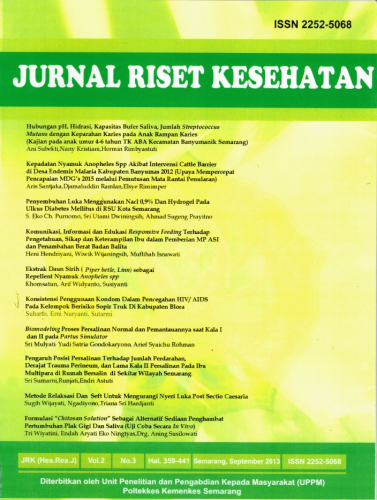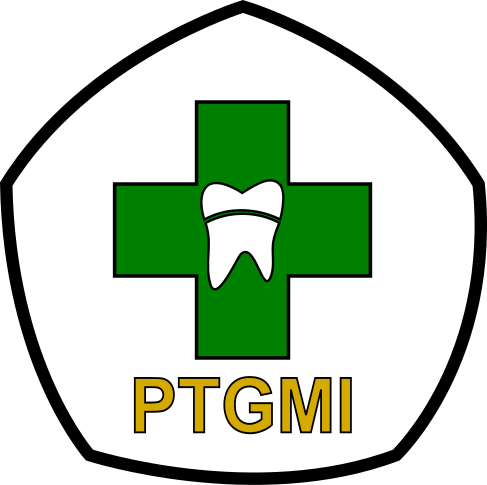FAKTOR-FAKTOR YANG BERHUBUNGAN DENGAN ELIMINASI FEKAL PADA PASIEN YANG DIRAWAT DI INTENSIVE CARE UNIT (ICU)
Abstract
Abstrak
Eliminasi fekal dibutuhkan untuk mempertahankan keseimbangan fisiologis melalui pembuangan sisa-sisa metabolisme. Saat eliminasi fekal terganggu, hal ini akan memperburuk keadaan pasien kritis yang tentu juga akan meningkatkan angka morbiditas dan mortalitas. Tujuan penelitian ini untuk mengetahui faktor- faktor yang berhubungan dengan eliminasi fekal pada pasien yang dirawat di ruang ICU RSUD Arifin Achmad Provinsi Riau. Penelitian ini menggunakan metode kuantitatif dengan rancangan Cross-sectional. Jumlah sampel pada penelitian ini adalah sebanyak 21 responden dengan menggunakan consecutive sampling. Pengambilan data menggunakan lembar observasi Bristool stool chart. Analisis yang digunakan adalah analisis univariat dan analisis bivariat menggunakan uji Chi-square, uji Fisher dan uji Mann Whitnney. Analisis bivariat pada penelitian ini adalah hubungan jenis pemberian nutrisi, keseimbangan cairan, tingkat aktivitas, pemberian obat dan hari rawat dengan eliminasi fekal. Hasil penelitian menunjukkan bahwa ada hubungan yang bermakna antara faktor lama hari rawat terhadap eliminasi fekal (p value less than 0.05) dan tidak terdapat hubungan yang bermakna antara faktor pemberian nutrisi, keseimbangan cairan, tingkat aktivitas, dan pemberian obat terhadap eliminasi fekal (p value more than 0.05). Saran pada penelitian ini agar perawat lebih memperhatikan faktor-faktor tersebut dalam menjaga keteraturan eliminasi fekal pasien ICU.
Abstract
[English Title: Factors Associated With Fecal Elimination Inpatients In The ICU Room RSUD Arifin Achmad Riau Province] Fecal elimination is needed to maintain physiological balance through the removal of metabolic remnants. When faecal elimination is impaired this will worsen the critical patient's condition which will also increase morbidity and mortality rates. This research purposed to find out the factors that contribute to faecal elimination in patients treated in the ICU RSUD Arifin Achmad Riau Province. This research was quantitative research with a cross-sectional design. The number of samples in this study was 21 respondents by using consecutive sampling. Data collection using the Bristol stool chart observation sheet. The analyze using univariate analysis and analysis bivariate using Chi-square test, Fisher test and Mann Whitney test. Analysis bivariate to determine the relationship between the types of nutrition ,activity level, fluid balance, drug and length of stay toward faecal elimination, The research results that there was a significant relationship between the length of hospital stay of treatment to the elimination of faecal (p-value = 0.005) and that there was no significant relationship between nutrition factor, fluid balance, activity level, and drug toward faecal elimination (p-value = 0.005). Suggestion on this research so that nurses give attention to maintain the faecal elimination of ICU patient.
Keywords
Full Text:
PDFReferences
Bararah, T., Jauhar, M. (2013). Asuhan keperawatan: Panduan lengkap menjadi perawat profesional (jilid 2). Prestasi Pustaka Jakarta
Engkartini (2017). Trend prevalensi penyakit diabetes melitus (dm) tipe 2 di rumah sakit Umum daerah (rsud) cilacap tahun 2009-2015. Jurnal Kebidanan 9(02), 101 -212. Diperoleh dari journal.stikeseub.ac.id/index.php/jkeb/article/download/253/228
Estri, A .K., Fatimah, S, & Prawesti, A. (2016). Perbandingan Abdominal Massage dengan tekhnik Swedish Massage dan tekhnik Efærage terhadap kejadian konstipasi pada pasien yng terpasang ventilasi mekanik di ICU.Jurnal akademi keperawatan Panti Rapih Yogyakarta. 3(4).225-235. Diperoleh dari http://jkp.fkep.unpad.ac.id/index.php/jkp/article/view/285
Fatmah. (2006). Respons imunitas yang rendah pada tubuh manusia usia lanjut. Makara Kesehatan, 10(1), 47-53 .Diperoleh dari journal.ui.ac.id/index.php/health/article/viewFile/169/165
Fithrah, B. A., Oetoro, B. J., Umar, N., & Saleh, S. C. (2016). Perdarahan berulang pascakraniotomi pada pasien cedera kepala ringan. Jurnal Neuroanestesi Indonesia 5(3), 173-179. Diperoleh dari http://www.inasnacc.org/images/Volume05no3Oktober2016/vol5no3oktober2016BonaAkhmadFitrah.pdf
Gacoin, A., Camus, C., Gros A, Isslame,S., Lavoue, S., Chimot, L., Donnio, P.Y., & Le Tulzo, Y. (2010). In long term ventilated patients: associated factors and impact on intensive care unit outcomes. Crit care med,38(10), 1933-8.Diperoleh dari https://insights.ovid.com/pubmed?pmid=20639749
Guerra, T.L., Mendonca, S.S., & Marshall, N.G. (2013). Incidence of constipation in an intensive care unit. Rev Bras Ter Intensiva,25(2), 8792. Diperoleh dari https://www.ncbi.nlm.nih.gov/pmc/articles/PMC4031832/
Gunawan, V. S., Arifin, J., & Ismail, A. (2015). Jumlah pasien masuk ruang perawatan intensif berdasarkan kriteria prioritas masuk di RSUP DR Kariadi periode Juli – September 2014. Jurnal Media Medika Muda, 4(4), 1561-1568. Diperoleh dari http://eprints.undip.ac.id/46236/1/Vanesa_Sefannya_22010111120013_Bab0.pdf
Guyot, A., Rawlins, M.D. & Barret, S. P. (2000). Clasrithrormycin appears to be linked with clostridium difficile- associated diarrhea in the elderly. Journal of Antimicrobial Chemotherapy 46, 642-3. Diperoleh dari https://academic.oup.com/jac/article/46/4/642/739807
Handayani, F. Angka Kejadian serangan stroke pada wanita lebih rendah daripada laki-laki. FK Universitas Diponegoro.1 ( 1 ), 17 - 21. Diperoleh dari https://jurnal.unimus.ac.id/index.php/JKMB/article/download/942/994
Ibnu, B, D.& Maskoen, T.T. (2014). Terapi nutrisi pada pasien ICU. Medica Hospital. Vol2(3), 140-148 Diperoleh dari https://www.medicahospitalia.rskariadi.co.id/index.php/mh/article/view/185/96
Jevon,P.& Ewens, B.(2008). Pemantauan pasien kritis (edisi 2).Jakarta: Erlangga
Kasiati, Rosmalawati, Dwi W. (2016). Kebutuhan dasar manusia 1.Jakarta : Pusdik SDM Kesehatan diperoleh dari bppsdmk.kemkes.go.id/pusdiksdmk/.../Kebutuhan-dasar-manusia-komprehensif.pdf
Kozier, B., Erb, G., Beiman., A., & Snyder, S. (2010). Buku Ajar Keperawatan Dasar : Konsep, Proses & Praktik.,(7th Ed)., Vol 2. Jakarta: EGC
Marcon, A .P., Monica, A. G., & Vianna, C. A. L. (2006). Nosocomial Diarrhea in the Intensive Care Unit. The Brazilian Journal of Infectious Diseases.2006, 10(6): 384-389. Diperoleh dari http://www.scielo.br/scielo.php?script=sci_arttext&pid=S1413-86702006000600005&lng=en&nrm=iso&tlng=en
Menteri Kesehatan Republik Indonesia, (2010). Peraturan Menteri Kesehatan Nomor 1778/MENKES/XII/2010. Pedoman Penyelenggaraan Pelayanan ICU di Rumah Sakit. Jakarta : Departemen Kesehatan.
Puri, Damayanti, H. (2007). Profil kejadia trauma kepala dirumah sakit daerah nganjuk periode 1 januari-31 desember 2007.1(1). Diperoleh dari http://eprints.umm.ac.id/2377/1/profil_kejadian_trauma_kepaladi_rumah_sakit_daerah_nganjuk_periode_1_januari.pdf
Setyani, F.A.R (2012). Dampak minuman probiotik dalam upaya pencegahan konstipasi pada pasien infact myocard di RSPAD Gatot Soebroto Jakarta (tesis). Jakarta : Universitas Indonesia. Diperoleh dari lib.ui.ac.id/file?file=digital/20302880-T30396-Dampak%20minuman.pdf
Sharma, K.S., Kaur, K., & Garg, R. (2007). Factors affecting bowel movementin critically ill patients. Nursing and Midwifery Research Journal,3(2), 7-78. Diperoleh dari http://medind.nic.in/nad/t07/i2/nadt07i2p71.pdf
Tanriono, C., Lalenoh, D, C., Laihad, M, L,. (2017). ProfilPasien Pasca Kraniotomi di ICU RSUP Prof. Dr. R. D. Kandou Manado Periode Juli 2016 -Juni 2017. Fakultas Kedokteran Universitas Sam Ratulangi Manado 274-278 Diperoleh dari https://ejournal.unsrat.ac.id/index.php/eclinic/article/download/18541/18068
Zahtamal., Chandra, F., Suyanto., & Restuastuti, T. (2007). Faktor-faktor risiko pasien diabetes melitus. Berita Kedokteran Masyarakat, 23(3), 142-147. Diperoleh dari https://jurnal.ugm.ac.id/bkm/article/view/3621/31
DOI: https://doi.org/10.31983/jrk.v7i2.3638
Article Metrics
Refbacks
Copyright (c) 2018 Ryan Andeska Artha




















































